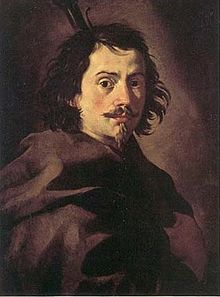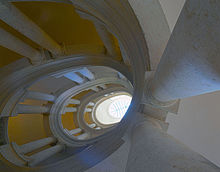Francesco Borromini
Francesco Borromini (actually Francesco Castelli; born September 25, 1599 in Bissone , Switzerland ; † August 2, 1667 in Rome ) was an architect working in Italy from what would become the canton of Ticino (Switzerland).
Life
At a young age, Francesco Castelli came to Milan and trained as a stonemason in the cathedral building there . After the apprenticeship years he settled in Rome . There he took the addition of Borromini to his name , possibly out of veneration of St. Charles Borromeo . From 1619 Borromini worked in the construction works at St. Peter's Basilica , which was directed by his uncle Carlo Maderno . During this time he studied the ancient world intensively and especially the works of his great role model Michelangelo . With his mentor and teacher Maderno he worked at Palazzo Barberini until he died. Gian Lorenzo Bernini took over the construction management and also received the office of the architect of Sankt Peter. Borromini worked under him as an assistant. After just a few years, there was a quarrel and rift between the two, and a lifelong rivalry began.
Pope Innocent X (1644–1655) granted Borromini his trust, which enabled him to oust his arch-rival Bernini from the position of leading Roman architect in the following years. But already under the next Pope, Alexander VII (1655–1667), Borromini lost this position and was only sparsely entrusted with new assignments. Bernini's star, on the other hand, shone again in full splendor. Borromini devoted himself to the expansion and completion of buildings that had already been started, such as the interiors of the churches of Sant'Ivo alla Sapienza , Sant'Andrea delle Fratte and San Giovanni in Laterano in Rome. He also completed the basement of the facade of his first work, the little church of San Carlo alle Quattro Fontane on the Quirinal in Rome.
In the summer of 1667, he suffered from depression , which finally led to his suicide on August 2nd. He was buried in the tomb of Carlo Maderno in the church of San Giovanni dei Fiorentini .
plant
While Bernini's formal language follows the classical canon and can largely be traced back to the model of Michelangelo , Borromini endeavored to give architecture a new kind of expression through an individual interpretation of the classical architectural forms. He worked with plastic, even organically shaped, mostly completely white interiors and concave curved facades. His idiosyncratic inventions earned him the reputation of being extravagant, “bizarre” and “Gothic”. One example of this is the “perspective” in the inner courtyard of the Palazzo Spada in Rome: the columns, which become smaller towards the rear, suggest a spatial depth that is not actually there, and in the end make the figure appear much larger than it actually is.
In its immediate aftermath, it initially lagged behind Bernini. Only in Guarino Guarini did he find a successor. In the 18th century, the late Baroque era , his decorative style, which was spread through engravings, was imitated in many places, for example in the Roman church of Santa Maria Maddalena built by Giuseppe Sardi in 1735 .
The greater part of Borromini's graphic oeuvre is now in Vienna in the Albertina Graphic Collection .
As in today's Switzerland-born artist Borromini was on the 100 Swiss franc - banknote represented the 1980s. On the occasion of the celebrations for Borromini's 400th birthday, a 33 m high wooden model was erected under the direction of Mario Botta in Lugano , which shows the section through the Church of San Carlo alle Quattro Fontane in original scale .
Buildings

- Oratory of the Filipinos next to the Chiesa Nuova
- Santi Apostoli (Naples) : Filomarino altar
- San Carlo alle Quattro Fontane
- Santa Lucia in Selci (restoration)
- Sant'Ivo alla Sapienza
- Sant'Agnese in Agone
- Basilica di San Giovanni in Laterano (Baroque style of the nave)
- Sant'Andrea delle Fratte (dome and bell tower)
- Santa Maria dei Sette dolori
- San Giovanni in Oleo (restoration)
- Cappella Spada , San Girolamo della Carità (with Virgilio Spada)
- Palazzo Barberini
- Palazzo Spada (Perspective Colonnade)
- Palazzo Pamphilj (ballroom and gallery)
- Palazzo Giustiniani (renovation)
- Palazzo Falconieri (renovation and decoration)
- Palazzo di Propaganda Fide
literature
- Joanna Beilman, Markus Breitschmid , (eds. :) San Carlo alle Quattro Fontane - Francesco Borromini . Architecture History Case Studies Series, Volume 1, Corporis Publisher for Architecture, Art, and Photography, 2009, ISBN 978-0-9802274-6-8 (English).
- Piero Bianconi : Francesco Borromini. Vita, Opere, Fortuna. Bellinzona 1967.
- Anthony Blunt : Borromini . Belknap Press of Harvard University Press, Cambridge MA 1979, ISBN 0-674-07926-4 .
- Richard Bösel (ed.): Borromini, architect in baroque Rome . Electa, Milan 2000, ISBN 88-435-7383-7 , (exhibition catalog).
- Laura Damiani Cabrini: Francesco Borromini. In: Historical Lexicon of Switzerland . September 20, 2017. Retrieved December 29, 2019 .
- Susanne Kunz-Saponaro: Rome and its artists . Scientific Book Society, Darmstadt 2008, ISBN 978-3-534-17678-6 , pp. 135 ff.
- Opera del caval. Francesco Boromino, cavata dai suoi originali cioè la chiesa, e fabrica della Sapienza di Roma con le vedute in prospettiva e con lo studio delle proporzioni geometriche, piante, alzate, profili, e spaccati. - Roma: Giannini, 1720. Digitized edition of the University and State Library Düsseldorf
- Paolo Portoghesi : Francesco Borromini . Electa, Milan 1967.
- Celestino Trezzini : Borromini In: Historisch-Biographisches Lexikon der Schweiz , Volume 2, Biondetti – Brupbacher , Attinger, Neuenburg 1921, p. 316. (accessed on June 30, 2017).
Web links
- Publications by and about Francesco Borromini in the Helveticat catalog of the Swiss National Library
- Literature by and about Francesco Borromini in the catalog of the German National Library
- Francesco Borromini on a private website on Ticino artists in Europe, 13. – 19. century
- Francesco Borromini. In: arch INFORM .
- Gabriele Pasch: Page about Borromini with numerous illustrations
- Publications by Borromini researcher Joseph Connors ( Memento of December 2, 2005 in the Internet Archive ) (via Internet Archive )
- Martin Raspe: Borromini's last project - the art historian Martin Raspe on Borromini's death; numerous drawings ( memento from June 20, 2007 in the Internet Archive )
- Borromini, Francesco. In: Sikart (accessed on: August 18, 2015).
- Francesco Borromini on ti.ch/can/oltreconfiniti
- Works by Francesco Borromini in the Albertina (Vienna)
| personal data | |
|---|---|
| SURNAME | Borromini, Francesco |
| ALTERNATIVE NAMES | Castelli, Francesco (real name) |
| BRIEF DESCRIPTION | Italian architect |
| DATE OF BIRTH | September 25, 1599 |
| PLACE OF BIRTH | Bissone , Switzerland |
| DATE OF DEATH | August 2, 1667 |
| Place of death | Rome |







